Revolutionize waste management with the innovative use of vertical composting garden towers. These unique structures offer a sustainable solution for effectively managing waste while simultaneously nurturing a vibrant garden. By harnessing the power of composting and vertical gardening, these towers provide a space-efficient and environmentally friendly way to grow plants and reduce waste.
Key Takeaways:
- Vertical composting garden towers revolutionize waste management
- These towers combine composting and vertical gardening
- They provide space-efficient and environmentally friendly solutions
- Vertical composting garden towers support plant growth and reduce waste
With the use of vertical composting garden towers, waste management takes on a whole new dimension. These towers are designed to efficiently compost organic waste materials while simultaneously providing a vertical space for plants to grow. The concept is simple yet effective – as waste decomposes, it generates nutrient-rich compost that nourishes the plants growing in the tower.
One of the major benefits of vertical composting garden towers is their ability to maximize space utilization. These towers take advantage of vertical space, allowing you to grow a significant number of plants in a limited area. Whether you have a small balcony or a tight backyard, vertical composting garden towers offer a solution to grow your own food and beautify your surroundings.
The functionality of vertical composting garden towers is impressive. As water is applied to the top of the tower, it moves through the connected soil levels, carrying nutrients with it. This constant circulation of water ensures that plants have access to the necessary nutrients for their growth. Additionally, the internal horizontal shelves prevent soil compaction and aid in the absorption of water back into the soil, extending the life of the potting soil.
Not only do vertical composting garden towers optimize space and nutrient delivery, but they also play a crucial role in waste management. By composting kitchen scraps and other compostable materials, these towers divert organic waste from landfills and instead transform it into valuable compost. This compost can then be used to enrich the soil and promote plant growth, creating a circular and sustainable system.
Maintaining and caring for vertical composting garden towers is relatively easy. Regular watering, adding compostable materials, and ensuring proper airflow are the key aspects of tower maintenance. With proper care, these towers can provide years of productive gardening and waste management.
Harvesting the compost produced in vertical garden towers is a rewarding process. Every 90 days, the compost can be removed from below the tower, reducing the volume of kitchen scraps by 10-20 times. This dark, rich compost can then be utilized to improve soil quality and enhance plant growth in other areas of your garden.
When selecting a vertical composting garden tower, it is important to consider factors such as size, durability, and ease of use. Choosing the right tower for your specific gardening needs will ensure optimal results and a smooth gardening experience.
In conclusion, vertical composting garden towers are a game-changer in waste management. They offer a sustainable and space-efficient solution for composting organic waste while simultaneously allowing for the growth of plants. By revolutionizing waste management practices, these towers promote a circular economy and contribute to a greener and more sustainable future.
How Vertical Composting Garden Towers Work
Vertical composting garden towers are designed to optimize the process of composting and gardening in limited spaces. These innovative structures allow you to grow plants and compost simultaneously, creating a self-contained system that maximizes space utilization and nutrient uptake.
The functionality of vertical composting garden towers is based on a series of interconnected soil levels. When you water the tower, soluble nutrients in the water are moved from one soil level to another, ensuring efficient nutrient uptake by the plants. This hydroponic-like system promotes faster growth and more nutritious plants.
One key feature of vertical garden towers is the inclusion of internal horizontal shelves, which prevent potting soil compaction and aid in the absorption of water back into the soil. This unique design helps extend the life of the potting soil and ensures optimal plant growth for years to come.
In traditional raised-bed or container gardening, a significant amount of available nutrition is lost below the root zone. However, vertical composting garden towers recover these nutrients and deliver them directly to the plant roots, resulting in hydroponic-like growth rates and minimizing nutrient loss.
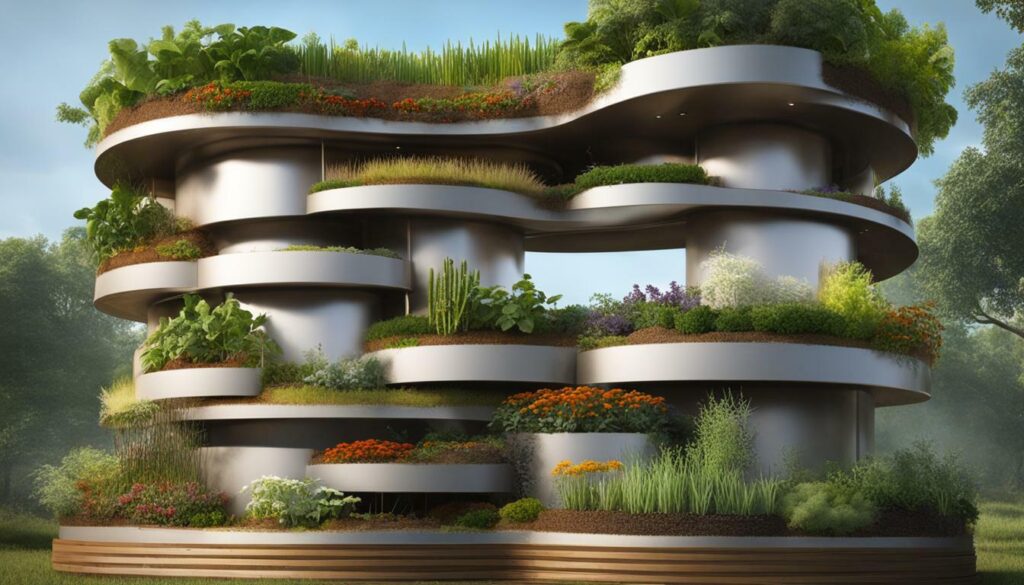
The composting process in vertical garden towers is facilitated through the addition of compostable kitchen scraps and “browns” (such as shredded paper) into the compost tube. Red worms are introduced into the tower to consume the kitchen compost as it begins to decay, creating a stable red worm habitat. These worms help transport nutrients and create pathways for maximum soil and compost aeration, further enhancing the overall efficiency of the system.
Plant roots in vertical garden towers have direct access to the compost column, allowing for natural nutrition uptake. This concept, though found in nature, is unique to the vertical garden tower system. Additionally, the tower is designed to facilitate easy harvesting of finished compost every 90 days during the growing season. The compost gate, which is fully perforated to maximize air entry, slides out, allowing the compost to drop into a removable drawer for convenient removal.
Enhanced Nutrient & Air Distribution
The patented GT2 vermicomposting tube featured in many vertical garden towers provides 265% more openings for greater access by plant roots and compost oxygenation. This ensures enhanced nutrient distribution and optimal soil aeration, resulting in healthier and more productive plants.
| Key Features | Benefits |
|---|---|
| Ample planting space in each tier | Accommodates various plants |
| Stackable design | Maximizes space utilization |
| Built-in water reservoirs | Reduces watering frequency |
| Durable construction | Ensures long-lasting use |
| Suitable for indoor and outdoor gardening | Provides flexibility |
Vertical composting garden towers revolutionize waste management by offering an innovative and efficient solution for composting and gardening in limited spaces. With their unique design and functionality, these towers provide opportunities for sustainable, nutrient-rich gardening and contribute to a greener and more eco-friendly environment.
The Benefits of Vertical Composting Garden Towers
Vertical composting garden towers offer numerous benefits, making them an ideal choice for eco-friendly waste management. These innovative systems revolutionize traditional methods of composting and gardening by combining them into a single, efficient solution. Here are some of the key advantages of using vertical composting garden towers:
1. Efficient Use of Space
Vertical composting garden towers maximize space utilization, making them perfect for small gardens, balconies, or even indoor gardening. By utilizing vertical space, these towers allow you to grow a significant number of plants in a minimal footprint. With multiple tiers or shelves, you can cultivate a variety of vegetables, herbs, flowers, and even strawberries, making the most of your available space.
2. Improved Nutrient Uptake
One of the notable benefits of vertical composting garden towers is the enhanced nutrient uptake by plants. As the tower is watered, soluble nutrients from the compost are moved from one root zone to another, facilitating their absorption. This results in faster plant growth and more nutritious crops. Additionally, the internal horizontal shelves prevent soil compaction and aid in water absorption, extending the lifespan of potting soil.
3. Sustainable Waste Management
Vertical composting garden towers play a vital role in waste management by enabling the recycling of organic materials. By adding compostable kitchen scraps and “browns” like shredded paper into the compost tube, you can divert waste from landfills and create nutrient-rich compost. This compost serves as a natural source of nutrition for plants, reducing the need for synthetic fertilizers. Additionally, the presence of red worms and nightcrawler worms further enhances the composting process and promotes optimal soil and compost aeration.
4. Easy Maintenance and Harvesting
Maintaining and caring for vertical composting garden towers is relatively simple. With the stability and durability of these systems, they require minimal upkeep. Regular watering, occasional harvesting of compost, and ensuring proper aeration are the primary tasks involved. The compost gate, designed to maximize air entry, allows for easy removal of finished compost, while the compost/nutrient tea drawer collects and stores nutrient-enriched water for reuse, eliminating wastage.
| Benefits of Vertical Composting Garden Towers |
|---|
| Efficient use of space |
| Improved nutrient uptake |
| Sustainable waste management |
| Easy maintenance and harvesting |
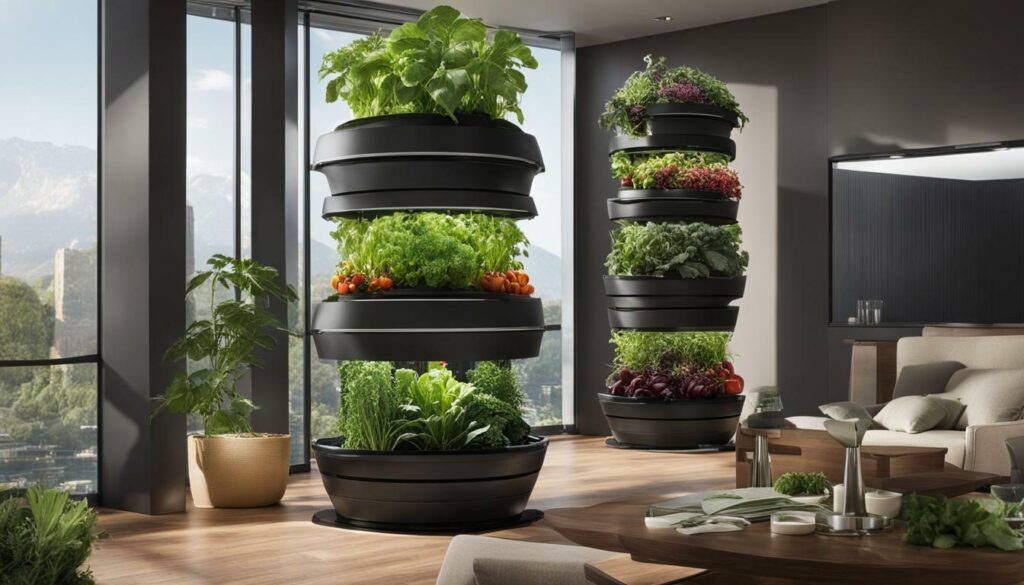
Vertical composting garden towers offer a practical and sustainable solution for both gardening and waste management. By embracing these innovative systems, individuals can create a thriving garden while actively reducing their environmental impact.
The Role of Composting in Waste Management
Composting plays a crucial role in sustainable waste management, and vertical garden towers provide an efficient way to compost organic waste. By composting, organic materials such as kitchen scraps and yard waste can be transformed into nutrient-rich soil that nourishes plants and reduces the amount of waste sent to landfills.
Vertical garden towers, such as the Vertical Composting Garden Tower, offer a unique solution for composting within limited spaces. These innovative systems allow for the simultaneous growth of plants and composting of organic waste, creating a self-contained and sustainable gardening environment.
The concept behind vertical composting garden towers is simple yet effective. As the garden tower is watered, the available nutrients in the soil are moved from root zone to root zone, optimizing nutrient uptake for faster and more nutritious plant growth. The internal horizontal shelves in the tower prevent soil compaction and aid in the absorption of water, extending the life of the potting soil.
In traditional raised beds or containers, a significant amount of available nutrition is lost below the root zone. However, the vertical composting garden tower recovers these nutrients and delivers them directly to the plant roots for efficient nutrient absorption. This results in hydroponic-like growth rates and healthier plants.
| Benefits of Vertical Composting Garden Towers in Waste Management |
|---|
| Efficient use of space, making them suitable for urban environments |
| Enhanced nutrient uptake for faster and more nutritious plant growth |
| Reduction of organic waste sent to landfills |
| Creation of nutrient-rich compost for soil enrichment |
| Promotion of sustainable gardening practices |
Vertical composting garden towers provide an ideal solution for individuals and communities looking to actively participate in waste management while also enjoying the benefits of fresh and nutritious homegrown produce. By incorporating these innovative systems into their gardening practices, individuals can contribute to a more sustainable future and enjoy the rewards of a thriving garden.
Incorporating Composting into Waste Management Practices
Composting is a simple and effective way to divert organic waste from landfills and turn it into a valuable resource for plant growth. By following a few basic guidelines, individuals can incorporate composting into their waste management practices:
- Collect kitchen scraps, such as fruit and vegetable peels, coffee grounds, and eggshells, in a compost bin or designated composting area.
- Add “browns” to the compost, such as shredded paper, leaves, or straw, to ensure a proper balance of carbon and nitrogen.
- Turn the compost regularly to aerate and accelerate the decomposition process.
- Monitor moisture levels in the compost to maintain a damp but not overly wet environment.
- Once the compost is dark, crumbly, and odorless, it is ready to be used as a nutrient-rich soil amendment.
By following these simple steps and utilizing a vertical composting garden tower, individuals can actively contribute to waste reduction and create valuable compost for their gardens. Vertical composting garden towers offer a sustainable and efficient solution for both waste management and plant growth, revolutionizing the way we approach gardening.
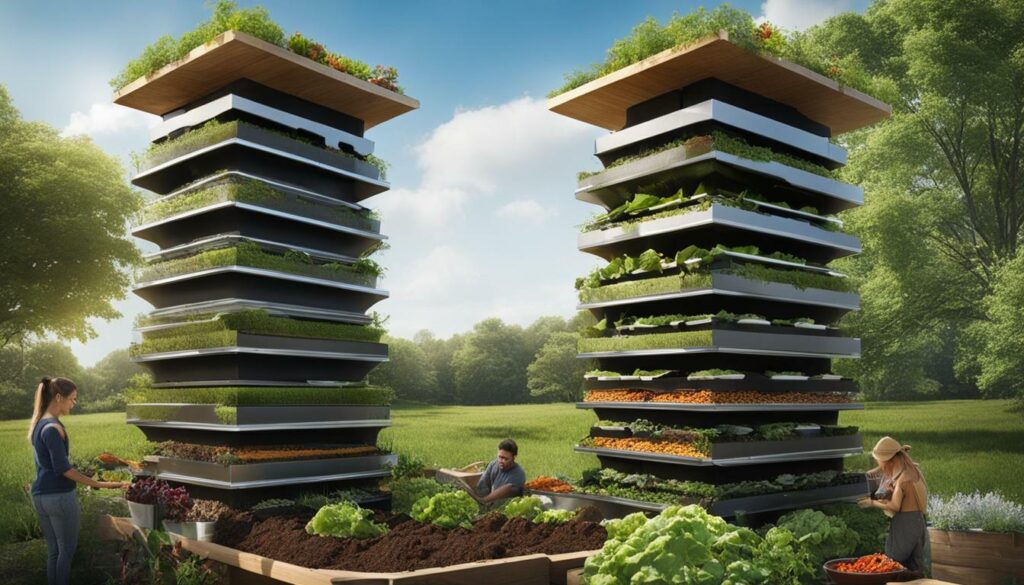
The Functionality of Vertical Garden Towers
Vertical garden towers serve as self-contained systems where plants can access nutrients directly from compost, ensuring optimal growth. These innovative structures revolutionize traditional gardening methods by providing efficient use of space and easy maintenance.
One key feature of vertical garden towers is their ability to harness the power of composting. By adding compostable kitchen scraps and “browns” such as shredded paper to the compost tube, gardeners can create a nutrient-rich environment for their plants. Red worms, which are introduced into the tower, consume the kitchen compost as it begins to decay. These worms stay near the fresh compost and are protected by the surrounding soil, making the tower much easier to maintain than traditional vermicompost systems.
Vertical garden towers also utilize the nutrient-rich compost column as a direct source of organic nutrition for plant roots. Plant roots can access the compost column naturally, mimicking the nutrient uptake process found in nature. This unique functionality enhances nutrient absorption and contributes to hydroponic-like growth rates.
Another advantage of vertical garden towers is their ability to recover and optimize nutrients that would otherwise be lost in traditional gardening methods. In raised beds or typical containers, over 90% of available nutrition is lost below the root zone. Vertical garden towers, on the other hand, recover these nutrients and deliver them directly to the plant roots, ensuring efficient nutrient uptake and faster growth.
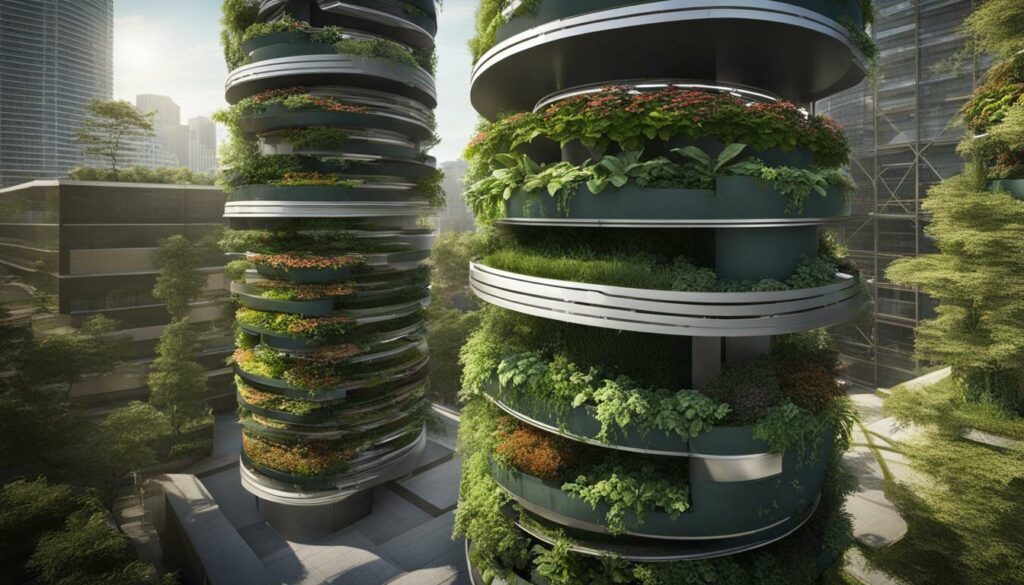
Furthermore, vertical garden towers offer the convenience of easy maintenance and harvesting. Finished compost can be removed from below every 90 days during the growing seasons, reducing the volume of kitchen scraps by 10-20 times. The compost gate, which is fully perforated, maximizes air entry into the compost from below and allows for aeration of the vermicompost. In addition, the tower features a removable compost/nutrient tea drawer that collects 2 gallons of nutrient-enriched water for another pass by the plant roots.
Overall, vertical garden towers provide a functional and efficient solution for gardening in limited spaces. Their unique design and functionality optimize nutrient uptake, reduce waste, and simplify the composting process, making them a valuable tool for any gardener seeking to revolutionize their waste management and maximize their plant growth.
Maintenance and Care of Vertical Composting Garden Towers
Proper maintenance and care are essential for the successful operation of vertical composting garden towers. These innovative gardening systems require attention to ensure optimal plant growth and composting efficiency. By following a few simple guidelines, you can enjoy a thriving garden while efficiently managing your waste.
Watering Frequency and Nutrient Uptake
Vertical composting garden towers have a unique watering system that helps distribute available nutrients to plant roots. In moderate climates, it is recommended to water the garden tower from the top with 4-6 gallons of water three times per week during peak summer growth. In spring and fall, reduce watering to 1-2 times per week. During winter, watering once a month is sufficient to maintain soil structure.
Each time the garden tower is watered, soluble nutrients in the soil are moved from root zone to root zone as the water passes through the connected levels. This enhances nutrient uptake, resulting in faster-growing and more nutritious plants. The internal horizontal shelves in the tower prevent potting soil compaction and aid in water absorption, extending the lifespan of the soil.
Composting kitchen scraps and “browns,” such as shredded paper, in the compost tube of the garden tower is another essential aspect of maintenance. Red worms play a crucial role in breaking down the kitchen compost and creating a stable habitat within the tower. These worms help transport nutrients and improve soil and compost aeration, making the garden tower system easier to maintain than typical vermicompost bins or bag systems.
Harvesting Compost and Nutrient Tea
Vertical garden towers offer the advantage of easy compost harvesting. Every 90 days during the growing seasons, you can remove dark, rich finished compost from below the tower. This compost is a valuable resource that can be used to enrich the soil, promote plant growth, and reduce waste volume by 10-20 times. The compost gate, which is fully perforated, allows for maximum air entry into the compost from below. By sliding out the gate, the compost drops into the drawer for convenient removal.
The drawer of the garden tower also serves as a collection point for nutrient-rich water or “nutrient tea” that exits the potting soil. This leachate contains a balance of essential nutrients for plants and can be reused by pouring it back through the potting soil, further enhancing the nutrient supply for your garden.
Proper maintenance and care of your vertical composting garden tower ensure optimal plant growth, efficient composting, and a continuous supply of nutrient-rich resources for your garden. By following these guidelines, you can revolutionize your waste management while enjoying the benefits of a flourishing garden.
| Key Maintenance Tips: | Benefits: |
|---|---|
| Water the garden tower 4-6 gallons three times per week in summer and 1-2 times per week in spring and fall. | Enhanced nutrient uptake, faster-growing plants. |
| Compost kitchen scraps and “browns” in the compost tube. | Reduces waste volume, provides a stable habitat for worms. |
| Harvest compost every 90 days and use it to enrich the soil. | Reduces waste volume, improves soil fertility. |
| Collect nutrient-rich water from the potting soil for reuse. | Optimizes nutrient availability, supports plant growth. |
Harvesting and Utilizing Compost from Vertical Garden Towers
Vertical garden towers produce nutrient-rich compost that can be harvested and used to nourish plants and improve soil health. These innovative gardening systems provide a self-contained environment where organic waste is transformed into a valuable resource.
By introducing compostable non-meat kitchen scraps and “browns” such as shredded paper, vertical garden towers create a balanced mixture of organic materials that undergo decomposition. As the composting process takes place, red worms play a crucial role in breaking down the kitchen compost and creating a stable habitat within the tower. These worms help transport nutrients and enhance soil and compost aeration.
One of the unique features of vertical garden towers is direct access to the compost column for plant roots. This natural nutrition source allows for hydroponic-like growth rates and ensures that plants receive essential nutrients for optimal development. Additionally, the nutrient-rich compost is periodically harvested from below every 90 days during the growing season. This dark, rich finished compost can be used to enrich the soil and promote healthy plant growth.
Benefits of Harvesting Compost from Vertical Garden Towers:
- Reduces the volume of kitchen scraps by 10-20 times, minimizing waste.
- Provides a steady supply of nutrient-rich organic compost for soil enrichment.
- Promotes sustainable gardening practices by recycling organic waste.
- Improves soil structure and enhances nutrient uptake for plants.
- Reduces the need for chemical fertilizers, supporting eco-friendly gardening.
Table: Comparison of Vertical Garden Towers for Compost Harvesting
| Garden Tower | Harvesting Frequency | Compost Volume | Additional Features |
|---|---|---|---|
| Mr. Stacky 5 Tier Stackable Planter | 90 days | Varies | Self-watering system |
| VIVOSUN 2-Pack 5 Tier Vertical Gardening Stackable Planter | 90 days | Varies | Ivory-colored design |
| TOREVSIOR 5 Tiers Vertical Garden Bed | 90 days | Varies | Elevated structure for easy access |
Harvesting compost from vertical garden towers is a simple and rewarding process. The compost gate, located at the bottom of the tower, is fully perforated to maximize air entry and can be opened to allow the compost to drop into a removable drawer. This compost, also known as “nutrient tea,” contains essential nutrients for plants and can be reused for another pass by the roots.
Vertical garden towers offer an innovative and sustainable solution for managing organic waste while creating a nutrient-rich resource for gardening. With the ability to directly access compost and harvest it periodically, these towers revolutionize waste management and provide a continuous supply of organic nutrition for plants.
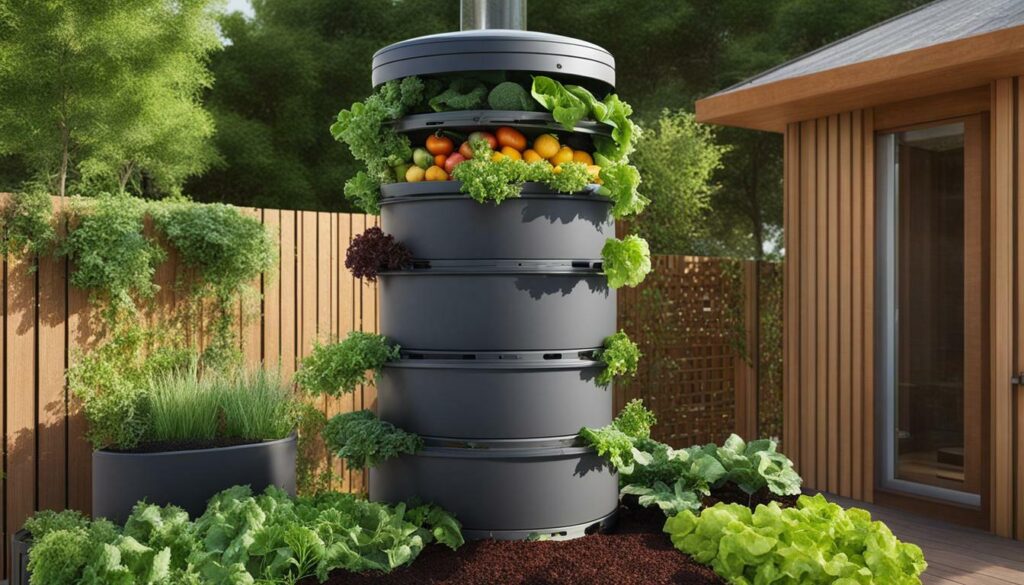
Choosing the Right Vertical Composting Garden Tower
Selecting the right vertical composting garden tower is crucial for achieving successful and sustainable gardening results. With a wide variety of options available in the market, it’s important to consider your specific needs and preferences before making a decision. Here are some key factors to keep in mind when choosing a garden tower system:
Space Availability
Assess the available space where you plan to set up your garden tower. Consider whether you have enough vertical or horizontal space for the tower to ensure proper installation and growth of your plants. Some garden towers are designed to be compact and suitable for small areas such as balconies or patios, while others may require more space.
Planting Capacity
Consider the number and types of plants you intend to grow in your vertical garden. Different garden towers offer varying levels of planting capacity, so ensure that the system you choose can accommodate your desired plant variety and quantity. Look for features such as multiple tiers or stackable designs that provide ample planting space.
Watering and Nutrient Delivery
Check whether the vertical composting garden tower has a self-watering system or requires manual watering. Some systems have built-in water reservoirs or irrigation mechanisms that help maintain proper hydration levels for your plants. Additionally, consider how nutrients are delivered to the plants. Look for features such as composting tubes or nutrient distribution mechanisms that ensure optimal nutrient uptake.
Durability and Material
Investigate the durability and quality of materials used in the construction of the garden tower. Ensure that it is made of weather-resistant and sturdy materials that can withstand outdoor conditions. Look for garden towers made from food-grade, UV-stable HDPE plastic, as these materials are designed to be long-lasting and safe for organic gardening.
By considering these factors, you can make an informed decision and choose a vertical composting garden tower that suits your gardening needs. Remember to follow the manufacturer’s instructions for installation and maintenance to ensure optimal performance and longevity of your garden tower system.
Conclusion
Vertical composting garden towers offer an innovative and eco-friendly solution to revolutionize waste management, providing a sustainable way to compost organic waste and grow plants in limited spaces. These towers utilize a stackable design, allowing gardeners to make the most of their available space and create beautiful vertical gardens indoors or outdoors.
By incorporating a self-watering system and built-in water reservoirs, vertical composting garden towers ensure that plants receive adequate hydration while minimizing water loss. The towers also optimize nutrient uptake, thanks to the direct access of plant roots to the compost column. This results in faster growth and more nutritious plants.
Not only do vertical composting garden towers benefit individual gardeners by providing an efficient and space-saving gardening solution, but they also play a crucial role in waste management. Composting organic waste in these towers reduces the amount of waste that goes to landfills, promotes the recycling of valuable nutrients, and helps create a sustainable cycle of plant growth.
When choosing the right vertical composting garden tower, it’s essential to consider factors such as the available space, the desired plant variety, and the specific features of each tower. With options ranging from stackable planters to elevated garden beds, there is a vertical composting garden tower to suit every gardener’s needs.
In conclusion, vertical composting garden towers offer an efficient, space-saving, and environmentally friendly solution for waste management and gardening. By incorporating these innovative systems, individuals can contribute to a more sustainable future while enjoying the benefits of fresh produce and beautiful gardens in even the smallest of spaces.
FAQ
Q: What is a vertical composting garden tower?
A: A vertical composting garden tower is a self-contained gardening system that combines composting and vertical gardening. It allows plants to grow directly from compost, making efficient use of space and nutrients.
Q: How do vertical composting garden towers work?
A: Vertical composting garden towers work by utilizing a central composting chamber that allows plants to access nutrients as they grow. The towers also feature multiple levels or tiers for planting, maximizing the number of plants that can be grown in a small space.
Q: What are the benefits of vertical composting garden towers?
A: Vertical composting garden towers offer several benefits, including efficient use of space, improved nutrient uptake for plants, and the ability to easily compost kitchen scraps and organic waste.
Q: What is the role of composting in waste management?
A: Composting is an essential part of waste management as it helps divert organic waste from landfills and reduces the production of greenhouse gases. Composting also produces nutrient-rich compost that can be used to enrich soil and promote plant growth.
Q: How do you maintain and care for vertical composting garden towers?
A: Vertical composting garden towers require regular maintenance, including monitoring moisture levels, adding compostable materials, and ensuring proper aeration. Regular checks for pests and diseases are also important.
Q: How do you harvest and utilize compost from vertical garden towers?
A: Harvesting compost from vertical garden towers can be done by removing the finished compost from the bottom of the tower. The compost can then be used to enrich soil in other garden beds or containers.
Q: How do you choose the right vertical composting garden tower?
A: When choosing a vertical composting garden tower, consider factors such as the size of the tower, the number of planting tiers, and the materials used for construction. It’s also important to consider the specific plants you want to grow and the available space you have.
Q: What are the key benefits of using vertical composting garden towers in waste management?
A: The key benefits of using vertical composting garden towers in waste management include reducing landfill waste, producing nutrient-rich compost, and promoting sustainable gardening practices.


